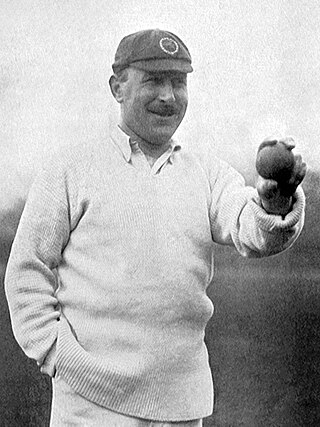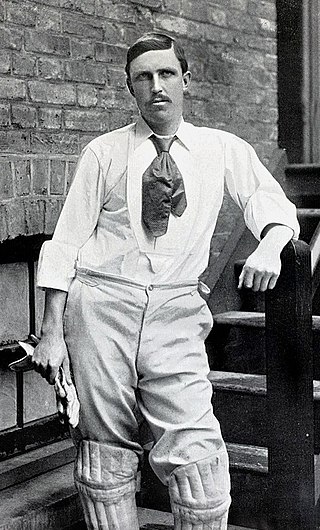Related Research Articles

Hedley Verity was a professional cricketer who played for Yorkshire and England between 1930 and 1939. A slow left-arm orthodox bowler, he took 1,956 wickets in first-class cricket at an average of 14.90 and 144 wickets in 40 Tests at an average of 24.37.

Robert Peel was an English professional cricketer who played first-class cricket for Yorkshire between 1883 and 1897. Primarily a left-arm spin bowler, Peel was also an effective left-handed batsman who played in the middle order. Between 1884 and 1896, he was regularly selected to represent England, playing 20 Test matches in which he took 101 wickets. Over the course of his career, he scored 12,191 runs and took 1,775 wickets in first-class cricket. A match-winning bowler, particularly when conditions favoured his style, Peel generally opened the attack, an orthodox tactic for a spinner at the time, and was highly regarded by critics.

Wilfred Rhodes was an English professional cricketer who played 58 Test matches for England between 1899 and 1930. In Tests, Rhodes took 127 wickets and scored 2,325 runs, becoming the first Englishman to complete the double of 1,000 runs and 100 wickets in Test matches. He holds the world records both for the most appearances made in first-class cricket, and for the most wickets taken (4,204). He completed the double of 1,000 runs and 100 wickets in an English cricket season a record 16 times. Rhodes played for Yorkshire and England into his fifties, and in his final Test in 1930 was, at 52 years and 165 days, the oldest player who has appeared in a Test match.
The 2005 English cricket season was the 106th in which the County Championship had been an official competition. Before it began, a resurgent England cricket team had won four Test series in a row, going unbeaten through the 2004 calendar year. The start of the international season saw England defeat Bangladesh 2–0 in their two-match series, winning both Tests by an innings. This was followed by a tri-nations one-day tournament that also featured Australia. Australia still started the Test series as favourites but most fans expected England to put up a challenge.

George Herbert Hirst was a professional English cricketer who played first-class cricket for Yorkshire County Cricket Club between 1891 and 1921, with a further appearance in 1929. One of the best all-rounders of his time, Hirst was a left arm medium-fast bowler and right-handed batsman. He played in 24 Test matches for England between 1897 and 1909, touring Australia twice. He completed the double of 1,000 runs and 100 wickets in an English cricket season 14 times, the second most of any cricketer after his contemporary and team-mate Wilfred Rhodes. One of the Wisden Cricketers of the Year for 1901, Hirst scored 36,356 runs and took 2,742 wickets in first-class cricket. In Tests, he made 790 runs and captured 59 wickets.
1890 was the 104th season of cricket in England since the foundation of Marylebone Cricket Club (MCC) and the first in which the County Championship was held as an official competition, following agreement between MCC and the leading county clubs at a meeting in December 1889. Surrey became the first official county champions after winning nine out of fourteen games.
1893 was the fourth season of County Championship cricket in England. For the first time, the official championship was won by a team other than Surrey, who finished fifth. Yorkshire, captained by Lord Hawke won twelve matches to take the title. It was the first of a record eight championships for Hawke as a county captain.

John Thomas Tyldesley was an English cricketer who played first-class cricket for Lancashire and Test cricket for England. He was a specialist professional batsman, usually third in the batting order, who rarely bowled and generally fielded in outfield positions.
1895 was the sixth season of County Championship cricket in England. It was the first season in which the official definition of first-class cricket was activated, following the 1894 ruling. Surrey won the championship for the fifth time in six years, despite increased competition, as the tournament was expanded from nine to fourteen teams. The points system was changed as the teams played differing numbers of matches and the new system involved division of the number of points gained by the number of matches that had ended in either a win or a loss. Draws were thus completely disregarded, as they gave zero points. Derbyshire was the best of the rookie teams, finishing in fifth place.

Lionel Charles Hamilton Palairet was an English amateur cricketer who played for Somerset and Oxford University. A graceful right-handed batsman, he was selected to play Test cricket for England twice in 1902. Contemporaries judged Palairet to have one of the most attractive batting styles of the period. His obituary in The Times described him as "the most beautiful batsman of all time". An unwillingness to tour during the English winter limited Palairet's Test appearances; contemporaries believed he deserved more Test caps.

1899 was the tenth season of County Championship cricket in England. Surrey won the championship for the first time in four years, but this title was their last until 1914. Surrey's season was dominated by draws, with fourteen out of 26 games drawn, just like the season in general – especially the Australian team's tour. Four of the five Test matches were drawn during the 19th series between the sides, but Australia won the second Test at Lord's and the series 1–0. This was their first Ashes series win in England since the original match in 1882.

Arthur Frederick Augustus Lilley, variously known as Dick Lilley or A. A. Lilley, was an English professional cricketer who played for Warwickshire County Cricket Club from 1888 to 1911, and in 35 Test matches for England from 1896 to 1909. He was born in Holloway Head, Birmingham, and died in Brislington, Bristol.

Herbert Tremenheere Hewett was an English amateur first-class cricketer who played for Somerset, captaining the county from 1889 to 1893, as well as Oxford University and the Marylebone Cricket Club. A battling left-handed opening batsman, Hewett could post a large score in a short time against even the best bowlers. Capable of hitting the ball powerfully, he combined an excellent eye with an unorthodox style to be regarded at his peak as one of England's finest batsmen.
1902 was the 13th season of County Championship cricket in England. Australia had won a classic Test series against England 2–1. The first two Tests were rained off but the final three were full of drama. Victor Trumper scored a century before lunch in the third Test, Australia won the fourth by just 3 runs and England won the fifth by one wicket following a century in 75 minutes by Gilbert Jessop. It was the 21st series between the two teams. Yorkshire won their third consecutive County Championship title and, as in 1901, went through the season with only one defeat.
The 1997 cricket season was the 98th in which the County Championship has been an official competition. The season centred on the six-Test Ashes series against Australia. England won the first, at Edgbaston, by the decisive margin of nine wickets, and the rain-affected second Test at Lord's was drawn, but any English optimism was short-lived. Australia won the next three games by huge margins to secure the series and retain The Ashes, and England's three-day victory in the final game at The Oval was little more than a consolation prize. It was the 68th test series between the two sides with Australia finally winning 3-2 The three-match ODI series which preceded the Tests produced a statistical curiosity, with England winning each match by an identical margin, six wickets.
1909 was the 20th season of County Championship cricket in England and featured a Test series between England and Australia. Kent won the championship and Australia, captained by Monty Noble, won the Test series.
1888 was the 102nd season of cricket in England since the foundation of Marylebone Cricket Club (MCC). There was a complete contrast to the previous sunlit summer with its record-breaking run-getting: this time the summer was exceptionally cool and wet, resulting in the dominance of bowlers with many records for wicket-taking set.
1871 was the 85th season of cricket in England since the foundation of Marylebone Cricket Club (MCC). Derbyshire County Cricket Club became a first-class club and the last matches were played by Cambridgeshire, who in the days of Bob Carpenter, the first Tom Hayward and George Tarrant had been one of the leading cricket counties.
1882 was the 96th season of cricket in England since the foundation of Marylebone Cricket Club (MCC). England lost to Australia in the match which gave rise to the Ashes.

The Australian cricket team toured England during the 1902 English cricket season. The five-Test series between the two countries has been fondly remembered; in 1967 the cricket writer A. A. Thomson described the series as "a rubber more exciting than any in history except the Australia v West Indies series in 1960–61". Australia had won the previous three Test rubbers between the two countries, and now won their fourth successive series, by two matches to one with two draws. In the process they "beat the records of all their predecessors in the country" by losing only two of 39 matches during the tour, their defeats being against England in the Fifth Test and in the first of their two fixtures against Yorkshire. The remaining 37 matches gave 23 wins for Australia and 14 draws.
References
- ↑ "Warwickshire v Yorkshire". cricketarchive.co.uk. Retrieved 3 September 2012.
- ↑ Wynne-Thomas, Peter (1983). The Hamlyn A-Z of Cricket Records. Hamlyn Publishing Group. ISBN 0-600-34667-6.